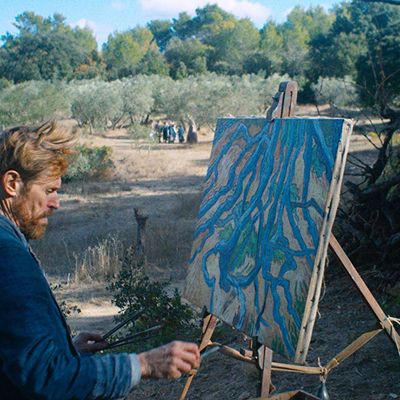
In the new Vincent van Gogh biopic At Eternity’s Gate, the artist and filmmaker Julian Schnabel doesn’t merely want you to see the increasingly volatile van Gogh (Willem Dafoe) but to see what van Gogh sees and to feel the painter’s fever — his lust not just for life but for the presence of Eternity (or the Divine or Name Your Higher Power) in the colors and shapes of this world. As an act of sympathetic imagination, the movie is only partly successful, but that part can take your breath away. The images vibrate with emotion.
It should be admitted that they vibrate largely because the camera is handheld and its operator is trying to whip himself up into a Dafoe-like frenzy. But the actor — constantly in motion behind his sad, hollow eyes — is infectious. He looked, to me, so uncannily like one of van Gogh’s self-portraits that I was surprised to go and reexamine the works and discover that Dafoe’s actual features (minus the red hair and beard) bear little resemblance to the painter’s. Dafoe just seems in his marvelous actorly way to be channeling van Gogh’s tipsy, questing, endlessly dissatisfied spirit. Dafoe (and Schnabel) plainly understand that this man who could be violent and who did, after all, slice off his own ear (though he never could remember how or why) had an essentially gentle soul. Oscar Isaac’s thinly written Gauguin has a key speech when he tells his friend that “the Impressionists are over — Renoir, Degas, Monet, they represent only themselves.” This van Gogh is looking hard at color (primarily yellow, in the film) as if trying to tune into — and match — the vibration of its molecules. He might well be grouped with the Impressionists (he’s technically a Post-Impressionist), but he wanted to capture not what he felt but what is.
At Eternity’s Gate charts van Gogh’s loopy odyssey from Paris to Arles — Gauguin advises his impoverished friend to go off and find “new light” — and in and out of sanitaria. There are wonderful scenes in which Dafoe’s van Gogh stumbles through the countryside, setting up his easel whenever the colors stir something in him. Schnabel isn’t aiming for lyricism but for a rough, even abrasive texture. Tatiana Lisovkaia’s score consists mostly of piano keys struck hard with the occasional moody slash of violin. Handmade, the movie is, like the paintings dashed off quickly before the emotion dissipates.
Schnabel has had practice getting inside his subjects’ heads, most successfully in The Diving Bell and the Butterfly, in which he re-created the paralyzed protagonist Jean-Dominique Bauby’s constricted universe from the inside out — an act of sympathetic disjunction. But in that case he had a fine Ron Harwood screenplay closely based on Bauby’s memoir (dictated one letter at a time via one fluttering eyelid). At Eternity’s Gate has strikingly clunky dialogue by Jean-Claude Carrière, Louise Kugelberg, and Schnabel. Even grading on the artist-biopic curve, the exchanges with Gauguin are flatfooted. The rapport between van Gogh and his brother (and sometime benefactor) Theo (Rupert Friend) is only slightly more human. The exception is a scene between van Gogh and Mads Mikkelsen as a priest who oversees the sanitarium in which van Gogh spends time in his final years. It is touching how gravely and tenderly Mikkelsen’s priest speaks as he directs the artist to examine one of his own paintings: “Look carefully, please … Don’t you see that this painting is … unpleasant, ugly?” Mikkelsen is so good that you can almost view the painting in that way, as a childish product of madness instead of a revolutionary masterpiece that would one day sell for approximately 50 million times its worth in van Gogh’s short, generally miserable life.
I’m not a fan of Schnabel’s paintings, but I think he’s a born film painter, and even if At Eternity’s Gate doesn’t reliably cross the blood-brain barrier, his frames are like no one else’s. (His cinematographer is Benoît Delhomme.) He will never take a light source for granted or let a face seem ordinary. As shot with his quivery camera, the rooms and furnishings have blurred edges that evoke van Gogh’s determined avoidance of definition. I’m not sure I can forgive Schnabel his final scene, however, in which van Gogh’s body lies in state in the middle of his paintings, on which wealthy mourners now bid. Having made his fortune in a very different kind of art market, Schnabel really has no place mocking the fickleness of patrons.
At Eternity’s Gate was nominated for an Oscar in 2019 for Best Actor.


